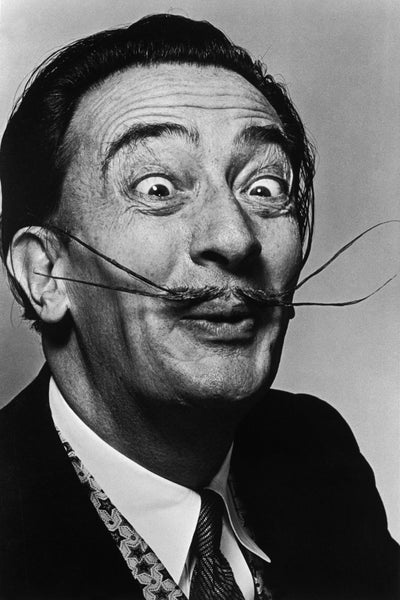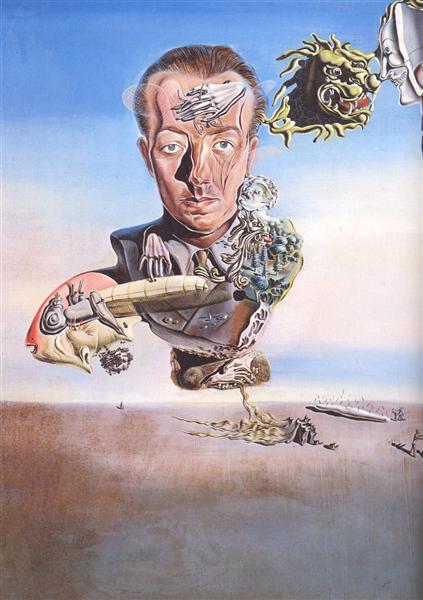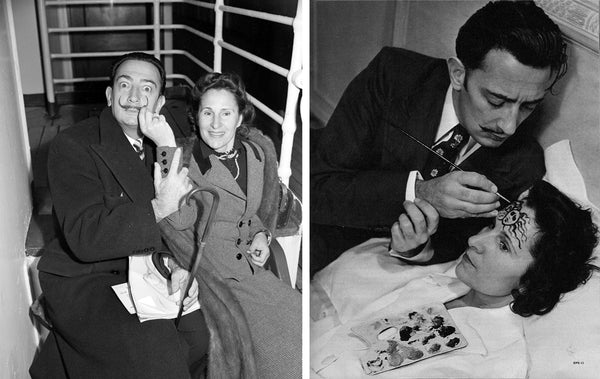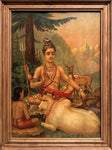Salvador Dali: Madman or Genius? 11 Bizarre Things You Didn't Know About the Surrealist Artist
It is rare to find a ‘normal’ photo of SALVADOR DALI, one of the most celebrated artists of all times. In most pictures, the Spanish artist’s eyes look like they are ready to pop from their sockets, his mustache has a life of its own, and animated expressions crown the overall eccentric allure.
 (Salvador Dali with his curious expressions and his pet dwarf leopard!)
(Salvador Dali with his curious expressions and his pet dwarf leopard!)
His life and portrayal of himself were as striking as his paintings, and an embodiment of his belief "I myself am surrealism". Even though Dali was an exceptional artist, his antics and stunts often overshadowed the brilliance of his work, much to the sadness of his admirers, and chagrin of his critics.
 ("Swans Reflecting Elephants" (1937), by Dali contains one of his most well-known optical illusions)
("Swans Reflecting Elephants" (1937), by Dali contains one of his most well-known optical illusions)
At the age of 16, Dali famously said "I'll be a genius, and the world will admire me. Perhaps I'll be despised and misunderstood, but I'll be a genius, a great genius, I'm certain of it." He spent the rest of his life proving this statement, and as he predicted, he was termed a madman by some, and genius by others.
 ("Slave Market with the Disappearing Bust of Voltaire", 1940 by Dali)
("Slave Market with the Disappearing Bust of Voltaire", 1940 by Dali)
On his birthday (May 11, 1904), here are 11 interesting and lesser known facts from his life and work.
1. Dali believed he was his brother reincarnated
Dali’s brother died exactly nine months before Dali was born. At the age of five, Dali was taken to his brother's grave and told by his parents that he was his brother's reincarnation. Dali completely believed in this concept and it greatly influenced his work, with images of his dead brother making an appearance in his paintings. Of these, Portrait of My Dead Brother (1963) is the most famous.
 ("Portrait of My Dead Brother" by Dali)
("Portrait of My Dead Brother" by Dali)
2. Yoko Ono paid $10,000 for a strand of Dali’s mustache and received a blade of grass in return
Dali’s waxed “tuned” mustache had a personality of its own and is one of the most influential pieces of facial hair in history. The Dali mustache even has an entire category dedicated to it at the World Beard Championships!
Yoko Ono requested Dali for a strand of his mustache and was asked to pay $10,000 for it. However, upon paying the amount the eccentric Dali sent her a blade of grass instead.
 (Salvador Dali's iconic mustache)
(Salvador Dali's iconic mustache)
3. Salvador Dali is the most valuable surrealist
Dali’s 1929 painting titled “Portrait de Paul Eluard” was sold at Sotheby’s for $22.4 million in 2011. It became the most expensive Surrealist work of art ever sold. The portrait was of Dali’s friend Paul Eluard, and reflected his admiration for the man.
 ("Portrait de Paul Eluard" by Dali)
("Portrait de Paul Eluard" by Dali)
4. Dali was a shameless self-promotor and his stunts nearly cost his life
In 1936, Dali delivered a lecture at the London International Surrealist Exhibition, inside a soundproofed glass bowl, wearing a deep-sea diving suit and helmet. Fans mistook his gestures resulting from asphyxiation as being part of the act. A gasping Dali was finally rescued from the helmet and he exclaimed that he was demonstrating how he was “plunging deeply into the human mind’.
 (Dali in his diving suit with attendees at the London Surrealist Exhibition; image source - Echostains)
(Dali in his diving suit with attendees at the London Surrealist Exhibition; image source - Echostains)
Besides this, Dali has pulled many other stunts like driving a Rolls Royce from Spain to France stuffed with 500 kilos of cauliflowers, and appearing at a ball dedicated to him, wearing a glass case on his chest, with a brassiere inside!
5. Dali has collaborated with two other masters of his time – Hitchcock and Disney
Walt Disney recognized Dali’s brilliance and hired him to help produce a film in 1945. The film, “Destino”, didn’t get made at the time as the production ran into financial trouble. However, the movie was completed by Walt Disney’s nephew, Roy E. Disney, in 2003 and features Dali’s artwork interacting with Disney’s animation. Dali also collaborated with Alfred Hitchcock and produced a dream sequence for Hitchcock’s movie Spellbound.
 (Walt Disney and Salvador Dali, 1946; image source: Konbini)
(Walt Disney and Salvador Dali, 1946; image source: Konbini)
6. Dali created two iconic surrealist objects - the Lobster Phone and the Mae West Lips Sofa
Edward James, a British poet, and supporter of the Surrealist Art Movement, commissioned Dali to create the iconic Lobster Phone and Mae West Lips Sofa. The phone had a plastic earpiece moulded in the form of a lobster. Interestingly, Dali drew sexual connotations between the telephone and lobsters.
 (The Lobster Phone)
(The Lobster Phone)
The Mae West Lips Sofa is a plump wood and satin sofa modelled on Hollywood actress Mae West’s lips. Dali was fascinated by Mae West and created many other artworks inspired by her.
 (The Original Mae West Lips Sofa created by Dali, which inspired many imitations over the years)
(The Original Mae West Lips Sofa created by Dali, which inspired many imitations over the years)
7. Dali claimed that filmmaker Joseph Cornell stole ideas from his subconscious
Halfway through the premier screening of surrealist filmmaker Joseph Cornell’s movie Rose Hobart, Dali knocked over the projector in a fit of rage. He claimed that Cornell had stolen the idea for the film from him, though Dali himself had never narrated the idea to anybody. He claimed that the movie was exactly what he had planned to make and that Cornell had “stolen his dreams”.
8. He experimented with meat dresses long before Lady Gaga
Way back in 1939, much before Lady Gaga donned the meat dress, Dali dressed live nude models with fresh seafood. Titled Dream of Venus, this creation displayed at The New York World Fair also featured bizarre statues and sculptures.
 (Dali dressed models with seafood for his installation, Dream of Venus)
(Dali dressed models with seafood for his installation, Dream of Venus)
9. Fellow artists and surrealists called Dali “Avida Dollars” or “eager for dollars”
Dali had a pompous lifestyle and an unabashed love for money. He charged admission fees for most shows and ventured into many commercial design projects. He collaborated with Christian Dior for fashion shows, designed the Chupa Chups Lollipop logo, and also appeared in an advertisement for Lanvin chocolates. This lead to Dali being called “Avida Dollars” or “eager for dollars” by fellow surrealist artists.
 (The familiar Chupa Chups logo designed by Dali)
(The familiar Chupa Chups logo designed by Dali)
10. Dali’s painting the “Persistence of Memory” is based on Einstein’s Theory of Relativity
Dali’s iconic painting, "Persistence of Memory" features a swarm of ants surrounding melting clocks and rotting flesh. These elements are symbols of the relativity of time, mortality and man’s ultimate decay. The melting clock went on to become one of Dali's most recognizable creations.
 ("Persistence of Memory" by Dali)
("Persistence of Memory" by Dali)
Dali continued to embed elements of science and mathematics within his paintings as they fascinated him. The subjects in his paintings from the 1950’s are composed of rhinoceros horns as Dali believed they were divine since they grow in a logarithmic spiral.
 (Dali with a rhinoceros; image source: iconicphotos.wordpress.com)
(Dali with a rhinoceros; image source: iconicphotos.wordpress.com)
11. Dali would be incomplete without his wife Gala
Gala, Dali’s wife and 10 years his senior, was his lifelong muse. It was an unconventional and tumultuous relationship from the beginning. When Gala met Dali, she was married to his friend Paul Eluard. She has inspired many creations like the Gala Chair and the painting “My Wife, Nude, Contemplating Her Own Flesh Becoming Stairs, Three Vertebrae of a Column, Sky and Architecture”.
 (Painting featuring Dali's wife, Gala)
(Painting featuring Dali's wife, Gala)
Dali bought Gala a castle in Spain, but he was only allowed to visit her there with prior permission! In the end, an old and senile Gala ended Dali’s artistic capability by dosing him with unprescribed medicines that impacted his nervous system.
 (Salvador Dali with his Russian wife, Gala)
(Salvador Dali with his Russian wife, Gala)
Salvador Dali died in 1989, 7 years after Gala, during which time, he had lost the will to live. During his lifetime, he created some of the most iconic artworks that will be remembered for centuries to come, and inspire artists around the world to push the envelope.






















































































